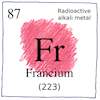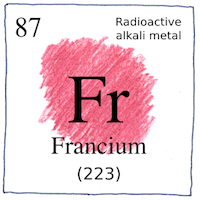Paris—Marguerite Perey
elements

|
Francium
After many erroneous discoveries, Marguerite Perey identified the new element contaminating a purified sample of actinium-227, which decayed to thorium-227 and francium-223. Extremely radioactive, francium has at least thirty four isotopes. The most stable isotope, francium-223, decays into astatine and radium with a half-life of less than 22 minutes.
Atomic number 87
D. K. Dobroserdov thought he had found it and named it russium. Gerald J. F. Druce and Frederick H. Loring thought they had found it and named it alkalinium. Fred Allison thought he had found it and named it virginium. Horia Hulubei and Yvette Cauchois thought they had found it and named it moldavium. When Marguerite Perey found it she named it actinium-K. Later, she wanted to name it catium, but Irène Joliot-Curie said catium sounded more like “cat” than “cation” so Perey suggested francium.
Unlucky 87
No stable isotope of francium has been found or synthesized. Nothing can be made of it. If it could be gathered, it would vaporize itself. Francium does not represent the universe my grandparents grew up with, in which atoms and stars were immutable and, kneeling before nature, we were nothing.



Francium was the last element to be found first in nature. All the remaining 29 known elements have been synthesized first. Although astintine, for example, occurs in nature, it was discovered first by bombarding bismuth with alpha particles.
See also in The book of science:
Readings in wikipedia:
Other readings: